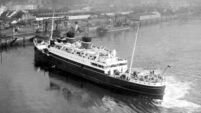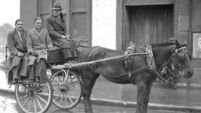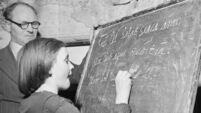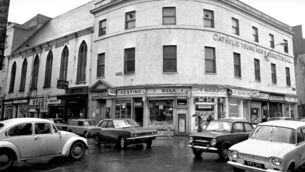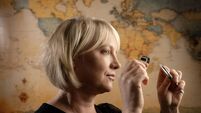The era when Easter meant austere in Cork
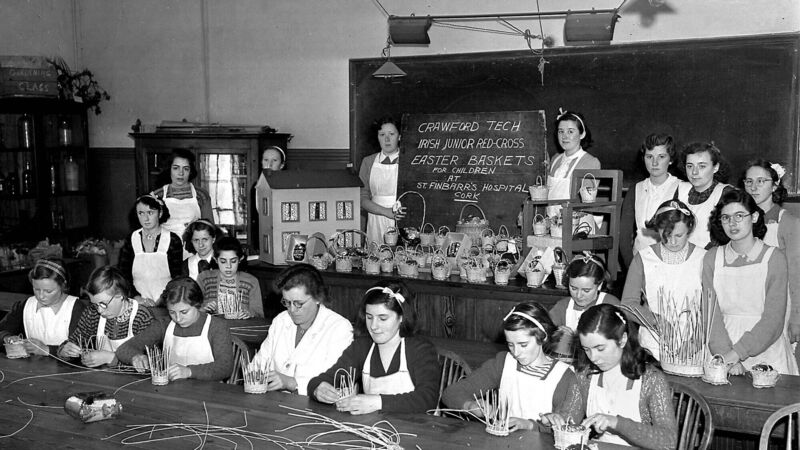
Members of Cork Junior Red Cross technical school making Easter baskets for local hospitals in April, 1952
READER Mary O’Leary saw the picture we published last week, sent in by Martin Humphreys, showing an unidentified and undated public occasion at the bottom of Cathedral Road in Cork city, and thought she could recognise some of the people in it.
Martin said he was old enough to remember Bishop Coughlan’s statue which faced up towards the infant Cathedral Road. One would assume that this was Bishop Daniel Cohalan who served as bishop of Cork from 1916 to 1952, but we would be glad to hear from anyone else who recalls this statue. New houses were being built at the time the picture was taken, and Martin could also identify St Mary’s Hall on the right, now a GP surgery.
“I think the Lord Mayor in the photo is Sean Cronin, who held the honour in 1944,” says Mary. “Over his shoulder, Sean McCarthy, who was Lord Mayor in 1949-50 and again in 1958, can be seen.
“All the horse-drawn transport would, I suspect, be as a result of petrol rationing during World War II. The TSB Bank was built 1956/7 so the first houses being built in the 1940s seems to make sense. I hope this helps.”
It does indeed, Mary. Your observation about horse-drawn transport coming back into use during The Emergency is absolutely right. They even returned to use on the Grand and the Royal Canal in the Irish midlands, drawing slow-moving barges once again, where motor-propelled craft had been used for decades before.
And here in Cork, the horses were hauled out of peaceful retirement to replace the petrol-driven lorries. One imagines that there might have been some difficulty locating enough horses for, say, CIE and the Innisfallen work, let alone grocery and goods deliveries around the city, but perhaps the animals still being used on farms around the county offered themselves to help?
So, we have a probable date for that picture of the 1940s, but still no idea what the occasion was that the dignitaries were celebrating. Any ideas out there?
Seeing the pomp and circumstance surrounding the event, though, does bring back memories of a time when we had parades and official openings and church processions every other week - or so it seemed to children growing up in the 1940s and ’50s.
Can you remember when there was a big Easter Parade in Cork? Katie O’Brien does:
“Our house fronted on to Summerhill but backed on to Wellington Road, and I can remember running out to see the soldiers marching down from Collins Barracks in fine style with their very smart officers in front. They had a band too, and often played The Star Of The County Down as their marching tune. We would sing along with it.
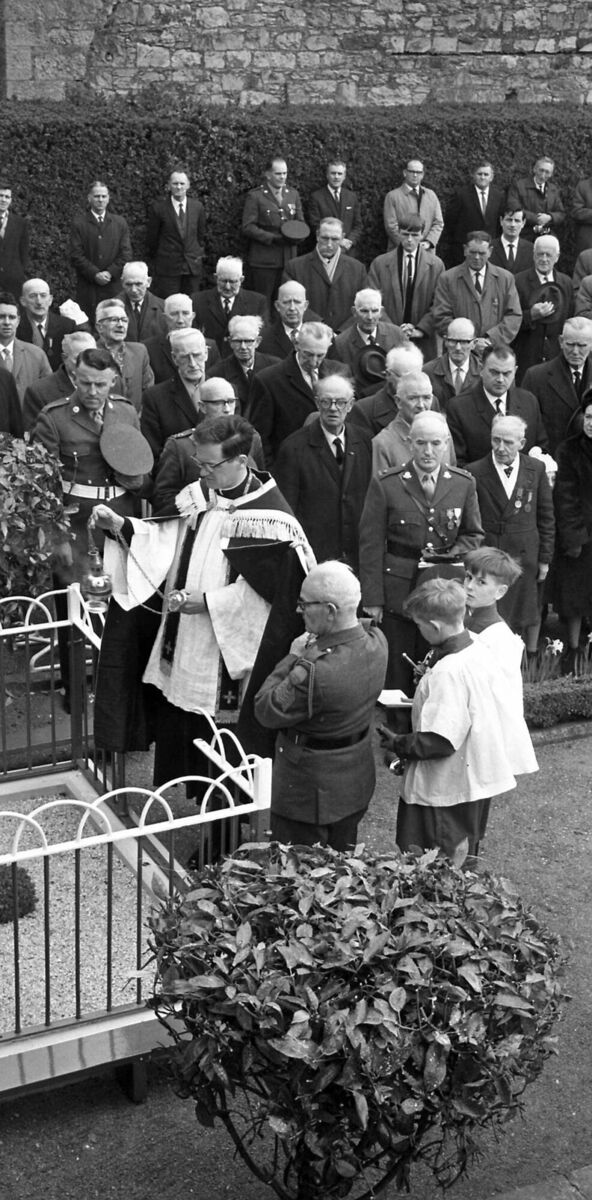
“In those days, everybody knew the words of the old songs, having heard them sung by the fireside or even by men wandering home from the pub late at night, the wavering words rising up to our bedroom window.”
From Bantry Bay up to Derry quay
And from Galway to Dublin town,
No maid I’ve seen like the brown colleen
That I met in the County Down...
Easter was a big event back then, she says, not only the excitement of the parade but also the delight of an Easter egg (singular, note, not the plethora of products piled upon today’s youngsters).
Eileen Barry remembers that special chocolate treat too, all the more special because it came only once a year.
“Ours came from O’Brien’s Ice Cream Parlour in MacCurtain Street. They had to be specially ordered to have your name on the top in pink icing and that was the biggest thrill of all - your very own personal Easter egg!
“You waited as long as you could before actually breaking into the perfect oval,” recalls Eileen, “First, you would chip off the pink icing that was piped all around the join, and then get a knife to try and take the two halves apart without breaking them. Inside there was a little bag of sweets - jujubes or fudge or, later on, little chocolates. They were very special.”
Eileen also remembers sometimes getting a new coat at this time.
“My mother would say that Easter was for new clothes, Christmas for presents. We were a large family and there wasn’t all that much money to spare, but she did try to get us something each year to wear in the coming seasons.
“I remember getting a lovely pink coat with a brown velvet collar one Easter - I must have been about 10 or 11.”
In those days, she emphasises, clothes were meant to last - and did.
“There was nothing like this wearing once and dumping that you see today. I wore that coat until I absolutely couldn’t fit it on any more (I was the youngest in the family, so it couldn’t be passed down.) It even featured in our games. We used to turn it, and other coats, inside out and wear them, calling ourselves the name that was inside the collar. I think mine was Bertola Regd!”
That reminds this writer of a little girl who called her new doll Pat Pending, because that was stamped on its back.
Yes, Easter was about joy and celebration, and although the Roman Catholic Church emphasised that this was because Christ had risen (they had, of course, taken over that tradition from the age-old belief in the Corn King who died in the autumn but came back in the spring to ensure good crops for the year ahead), for children everywhere it was far more about the ending of Lent and the self-imposed ‘giving ups’ that they had endured - a return to happier, more normal times.
But Good Friday then was a terrifying time. Whether at school or at home, the approach to this sombre date was the same. It was taught in many schools that it always rained between noon and 3pm on that day, to mark the Crucifixion, and, given our Irish climate, that was probably the case in most years.
Control on behaviour was absolute, and most if not all of the usual daily amusements of children were banned. How many of you can remember not being allowed to play out of doors on Good Friday, or being discouraged even from playing with toys?
Jane Wilson remembers that she was not allowed to read any of her favourite books on Good Friday.
“My father, who was very strict, would issue those he felt were ‘suitable’ for the day. One year he handed me a bound volume of The Strand Magazine (a Victorian monthly which published short stories and episodes from longer books, including writers like Arthur Conan Doyle and H. Rider Haggard). I soon discovered all the chapters of ‘She’ and devoured them throughout the day, horrified and enthralled by turns. Even back then I wondered if he would have given me that book if he had known just how wild and adventurous the story was!”
And for adults, particularly lively young men, Good Friday was a gloomy gap in the calendar. Pubs were absolutely forbidden to open, and shops were shut.
“There was nothing like knowing you couldn’t get a pint for love nor money that put a fierce thirst on you,” recalls Finbarr McCarthy. “A group of us used to trek out beyond Ballyvolane to a pub we knew where they would hand out pints by the back window. It wasn’t that you needed it so much, but that you were forbidden to have it. A bit like the effect of Prohibition in the United States, I suppose. Our own Day of Prohibition.”
I noticed a post on Facebook the other day which asked if Good Friday should not be a public holiday when places of business were closed. What? Listen, this new Utopian existence, where shops and pubs are open round the clock, around the year, apart from Christmas Day and Easter Sunday, is of relatively recent occurrence.
Whoever posted that clearly comes from a newer world where, if you want a burger at 2am or need to order a new laptop from the Aran Islands at midnight, there isn’t a problem. Back in the 1950s, when they said everything must be closed, they meant it.
There probably was some merit in the bad old days. They certainly made you appreciate returning to normality. Like after the pandemic, really. Remember seeing the queues round the corner at Penneys and other shops?
Going even further back, a century or so, Holy Week imposed a full seven-day period of additional fasting. Black tea, dry bread, potatoes with salt (but no butter or buttermilk) and perhaps a little porridge made up the daily fare of this difficult week until the Friday itself, when some families denied themselves anything other than dry bread and water. This, after the entire length of Lent, which of course had its own fasting demands, must have been hard to take, even in an era when food was not as plentiful as it is today. In the mid-19th century, the Roman church relented, and officially relaxed this extra fasting to just two days.
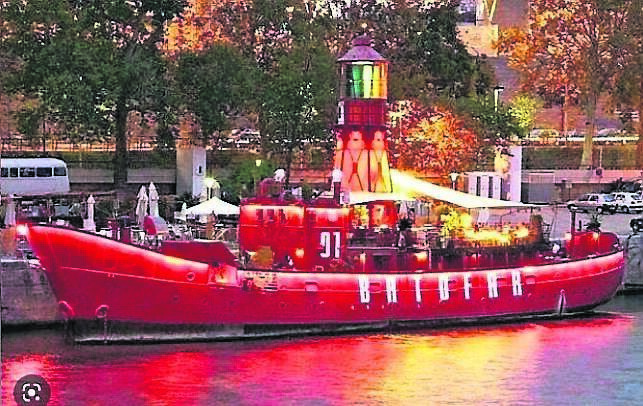
Now - remember that stirring story we featured last week, of the Mary Stanford, that courageous little Ballycotton lifeboat that rescued the crew from the Daunt Rock lightship during a terrifying storm? Tim Cagney sent us a nice follow-up snippet to that tale of the sea.
“To return - briefly - to the waters of Cork Harbour, you might be interested to know that the last-ever lightship to stand guard over the Daunt Rock, the Osprey, was taken out of commission and towed away on August 30, 1974. That brought an end to the era of lightships. These days, the Rock (or, rather, the passing shipping) is protected by a high-tech gadget known as a beacon-buoy.”
The Osprey first went to the New Ross Harbour Commissioners for use as a floating oil berth, a pilot station, and a harbour store, but in 1988, when it could well be considered to be approaching old age, took on a new and far more exciting life, says Tim.
It is now a very trendy nightclub, moored on the Seine in the 13th arrondissement of Paris. Re-named Le Batofar (le bateau-phare, or lighthouse boat) it hosts cutting-edge electro bands and DJ-driven after-hours dance parties.
If you happen to be in Paris, but don’t fancy the late night wild sessions, don’t give up, it does function during the day as a restaurant and café.
During August, when central Paris is turned into a pseudo-seaside town, Le Batofar is one of the big ‘beach hangouts’. Would you get a pint of Murphy’s there, though? Actually, you probably would. Let us know if you do.
Tell us your own recollections of Good Friday and the Easters of yesteryear. Or any other memories of growing up in a city that was quieter, less lavish, and definitely more set in its ways than it is today. Email jokerrigan1@gmail.com or leave a comment on our Facebook page: https://www.facebook.com/echolivecork.
